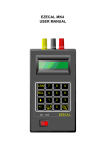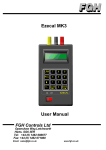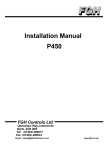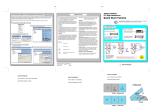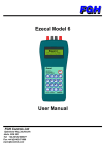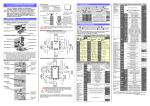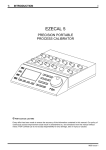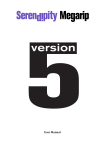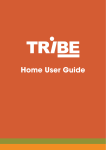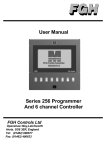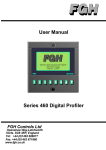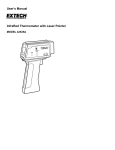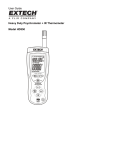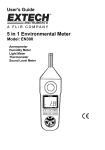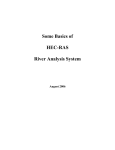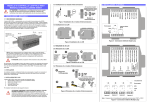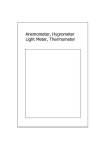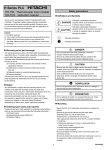Download EZECAL Mk3 INSTRUCTION MANUAL
Transcript
Ezecal Model 3S User Manual FGH Controls Ltd Openshaw Way,Letchworth Herts. SG6 3ER Tel: (01462) 686677 Fax: (01462) 480633 Email: [email protected] www.fgh.co.uk Ezecal 3S User Manual 1 EZECAL 3S User MANUAL Contents 1 General. 1.1 Battery installation, replacement and recharging. 1.2 Nomenclature. 1.3 Connecting the EZECAL in simulation mode. 1.4 Using the keyboard. 2 Setting up the EZECAL. 2.1 Setting the thermocouple type. 2.2 Selecting the temperature units. 2.3 Selecting Cold junction Compensation mode. 2.4 Cold junction compensation temperature. 3 Thermocouple simulation. 3.1 Simulation mode display indications. 3.2 Manual temperature simulation. 3.3 Learn Mode. 3.3.1 Programming a series of temperatures. 3.4 Recall mode. 3.4.1 Recalling a series of temperatures. 4. Specifications. 4.1 Physical. 4.2 Electrical. 4.3 Conformity Table. 2 2 3 4 5 6 6 6 7 7 8 8 8 9 9 10 10 12 12 12 12 M47 Issue 1 2 1 Ezecal 3S User Manual General. Thank you for purchasing this superb piece of British engineering. If you look after it carefully it will reward you with many years of faithful service. 1.1 Battery installation, replacement and recharging. The EZECAL is supplied with 4 off "AA" size nickel cadmium batteries. These batteries may be recharged as required using the optional EZECAL recharging unit. If necessary the batteries may be replaced with alkaline or zinc/carbon batteries, however these must be thrown away when they run out and, under no circumstances should any attempt be made to recharge them. - + Cell size AA R6 MN1500 To install new batteries, first ensure the EZECAL is switched off and remove the lid of the battery compartment by lightly pressing the region marked "OPEN" and sliding the lid towards the terminals. Remove the old batteries and dispose of them carefully. Fit the new batteries observing the polarity markings printed inside the compartment and on the battery and refit the lid. The EZECAL is now ready for use. Recharging Nickel Cadmium batteries. The EZECAL may be recharged either from the optional mains adapter or car cigar lighter adapter. To recharge, first switch off the EZECAL and then plug the charging lead into the side of the unit. Leave the unit for 16 hours to fully charge the batteries. The EZECAL will provide approximately 20 hours of continuous use with freshly charged batteries. If necessary the EZECAL may be used whilst charging is in progress, in this case recharging will take slightly longer to complete. WARNING. DO NOT USE THE CHARGER UNIT TO POWER THE EZECAL EXCEPT WHEN RECHARGEABLE BATTERIES ARE FITTED. M47 Issue 1 Ezecal 3S User Manual 3 1.2 Nomenclature. Black (Negative) Terminal Red (Positive) Terminal FGH Controls Ltd EZECAL 3S V2.20 LCD Display Charging Socket LRN RCL B 7 N 8 K 4 T 5 9 E 6 Keypads S1 +/- R2 CLR L 0 J 3 ENT EZECAL ON OFF On/Off Switch B 7 N 8 K 4 T 5 E 9 LRN Learn mode select button 6 RCL Recall mode select button Function select/Scoll button S1 R2 L J 3 +/- Sign change/Toggle button CLR Clear/Backward step button ENT Enter/Forward step button 0 Numeric Keypad & sensor Selection keys M47 Issue 1 4 Ezecal 3S User Manual 1.3 Connecting the EZECAL in simulation mode. The EZECAL unit is intended for the calibration and checking of temperature measurement or control instruments using any of the BS 4937 standard thermocouples. The simulator eliminates the need for thermocouple emf look up tables, tedious cold junction calculations and temperature units. For thermocouple simulation purposes the EZECAL unit can be connected to the instrument under test in three different ways. AUTOMATIC COLD JUNCTION METHOD. The EZECAL is wired to the instrument under test in the appropriate compensation cable. The EZECAL should be set to its AUTO cold junction mode (see section 2.3). In this mode the EZECAL will automatically measure the temperature of its own terminals and adjust the output emf to compensate. Compensating cable CJ + 1234 MANUAL COLD JUNCTION METHOD 1 The EZECAL is wired in copper cable to a reference junction and hence in the appropriate compensating cable to the instrument under test. For this method of connection the EZECAL should be set to its MANUAL compensation mode and the temperature of the reference junction entered. (see sections 2.3 and 2.4). The reference junction point can be any stable or temperature controlled environment between -10 and +55 °C. (melting ice is commonly used as a reference environment of 0 °C). Copper cable Compensating cable + CJ Reference Junction M47 Issue 1 1234 Ezecal 3S User Manual 5 MANUAL COLD JUNCTION METHOD 2 The EZECAL is wired in copper cable to the instrument under test. For this method the simulator should be put into its MANUAL compensation mode and the temperature at the terminals of the instrument under test entered. (see sections 2.3 and 2.4) This method of connection is the least reliable of the three described and should only be used for rough checking, as changes in ambient temperature will affect the readings on the instrument under test. Copper cable + - CJ 1234 1.4 Using the keyboard. The numeric keypad on the EZECAL is used just like a calculator. To enter a number simply press the numeric keys in the usual order. On the first key press the existing number will be cleared and a flashing cursor and question mark will appear. The cursor indicates where the next number pressed will be displayed. Digits already entered will be shifted one space to the left. The ENT key must be used at all times to enter the number, at which point the cursor and question mark will disappear. Negative numbers are entered by using the +/- key to negate the number entered at any time. Mistakes can be corrected by pressing the CLR key at any time during input and reentering the correct number. Alternatively the incorrect number may be overwritten by the correct one after pressing the ENT key. Examples. Entering a positive number Entering a negative number existing display +1000°C S 1 + 1? R 2 + 12? J 3 + 123? ENT + 123°C existing display +1000°C S 1 + 1? L 0 + 10? 0 + 100? L +/- - 100? ENT - 100°C M47 Issue 1 6 Ezecal 3S User Manual Correcting a mistake Entering a number out of limits existing display +1000°C 2 S 1 + 1? R 2 + 12? CLR + ? S 1 + 1? J 3 + 13? ENT + 13°C existing display +1000°C S 1 + 1? B 7 + 17? ENT Error S 1 + 1? E 6 + 16? ENT + 16°C Setting up the EZECAL. This section describes how to set up the EZECAL to simulate the particular thermocouple of interest, the temperature units and the cold junction compensation mode. 2.1 Setting the thermocouple type. The EZECAL can simulate three of the standard thermocouple types specified under BS 4937, these are :Pt10%Rh/Pt type S Pt13%Rh/Pt type R NiCr/NiAl type K and equivalents in °F. -50 to 1767 °C -50 to 1767 °C -270 to 1372 °C The sensor type is set by using the scroll key until the thermocouple type is displayed and then pressing a numeric key to set the required type. For example. OUTPUT Type:S Thermocouple S Select S, R or K Display shows current type 4 Now press ENT to confirm type K To set type K ENT Thermocouple K Select S, R or K To confirm change +1760°C CJC:Man K 2.2 Selecting the temperature units. The EZECAL can work in either °C or °F. To change the temperature units press the SCROLL key until the temp units message is displayed, and then use the +/- key to toggle between °C and °F. M47 Issue 1 Ezecal 3S User Manual For example. 7 Temp Units °C Select Using +/Temp Units °F Select Using +/- until +/- Display shows current units are degrees C Changed units to degrees F 2.3 Selecting Cold junction Compensation mode. The EZECAL is capable of measuring the temperature of its terminals and adjusting the simulated output accordingly. This automatic adjustment can be switched on or off as required depending on the way the unit is connected (see section 1.4). If compensation cable is used to connect the EZECAL to the thermocouple or instrument then the automatic mode should be used. If, however an external reference junction is used then the manual mode should be selected and the reference temperature should be entered. To switch between automatic or manual compensation, press the SCROLL key until the compensation message is displayed. Then use the +/- key to toggle between AUTO and MANUAL. For example .. until +/- Cold junct auto Select Using +/- Display shows auto mode selected Cold junct man Select Using +/- Changed mode to manual 2.4 Cold junction compensation temperature. For operation in manual cold junction mode, it is up to the user to enter in the actual cold junction temperature. The location of the cold junction depends on how the EZECAL is wired (see sections 1.3 and 1.4). The valid range for this temperature is -10 to +55 °C or 14 to 131 °F. The lower line of the display indicates the valid range. In Automatic compensation mode there is no need to enter this temperature, the EZECAL will measure the temperature automatically and its value will be shown on the display. If this measured temperature is outside the specified limits of -10 to +40 °C (or equivalent) and error message will be displayed. for example in MANUAL CJC mode. .. until CJ Temp + 24.0°C From -10 to 55°C 2 CJ Temp + .2? From -10 to 55°C N8 CJ Temp + 2.8? From -10 to 55°C T 5 CJ Temp + 28.5? From -10 to 55°C ENT CJ Temp + 28.5°C From -10 to 55°C R Existing CJ temp is displayed M47 Issue 1 8 Ezecal 3S User Manual A new cold junction temperature of 28.5 °C has now been entered. In AUTOMATIC CJC mode. Display shows internally measured CJ temperature. CJ Temp + 24.2°C Display indicates measured CJ temperature is out of range. CJ Temp + Error *CJ RANGE ERROR* 3 Thermocouple simulation. Simulation mode is used to simulate the set thermocouple type. The required temperature is entered on the keypad and the equivalent emf with compensation if required will be output to the terminals directly after the ENT key is pressed. 3.1 Simulation mode display indications. Simulation mode is recognised by the word "OUTPUT" appearing on the top line of the display. The current set-up and actual temperature being simulated is also displayed along with any error conditions that may arise. Simulated temperature Temp units OUTPUT Type:K Sensor Type °C °F +1000°C CJC:Auto S R K Cold Junction mode Auto Man 3.2 Manual temperature simulation. In simulation mode the required temperature is simply entered on the keypad and, if valid, will appear at the output terminals upon depression of the ENT key. If the entered temperature is outside the valid range for the sensor selected then an error screen will appear:- OUTPUT Error * OUT OF RANGE * This error is quickly cleared by simply pressing CLR or re-entering a valid temperature:- OUTPUT Error * OUT OF RANGE * CLR M47 Issue 1 OUTPUT ? * OUT OF RANGE * Ezecal 3S User Manual To enter a temperature for simulation. For example 1000 °C:S 1 L 0 L 0 L 0 ENT 9 OUTPUT Type:K +1000°C CJC:Auto OUTPUT Type:K - 200°C CJC:Auto Negative temperatures are also easily entered:+/- R 2 L 0 L 0 ENT 3.3 Learn Mode. The LEARN mode is used to program the simulator to produce a series of temperatures. This is useful if, for instance the user wishes to check the calibration of several instruments at various positions in their range. In this case the user could use learn mode to teach the simulator the required list of temperatures. Then using the RECALL mode each instrument could be checked very quickly and easily by recalling each test temperature with a single keystroke. Alternatively the time base facility could be used to automatically step through the sequence of temperatures without user intervention. 3.3.1 Programming a series of temperatures. In order to teach the simulator a series of temperatures, The EZECAL must be in SIMULATE MODE (see section 3.0). LEARN mode is activated simply by pressing the LRN keypad. OUTPUT Type:K LRN +1000°C CJC:Auto Lrn 0 + 0 Enter reqd value From Simulate mode Enter LEARN mode The LEARN mode display. Value programmed for current step Step number 0-9 Indicates LEARN mode Lrn 0 +1234 Enter reqd value Learn mode can store up to 10 step values. Each step is assigned a number 0 to 9 and this is shown on the display at all times. To teach the EZECAL a new step value the SCROLL key should be used to select the required step number:- OUTPUT Type:K ... E 6 L 0 Until L 0 ENT +1000°C CJC:Auto Lrn 6 + 0 Enter reqd value Lrn 6 + 600? Enter reqd value Lrn 6 + 600 Enter reqd value Select step required Enter step value Use ENT to store value M47 Issue 1 10 Ezecal 3S User Manual The step values shown in learn mode are unitless and could be °C or °F. This allows the user the flexibility of recalling the programmed steps with any sensor type or temperature units required. To exit from learn mode:- LRN Lrn 6 + 600 Enter reqd value In LEARN mode OUTPUT Type:K Press LRN again to exit +1000°C CJC:Auto 3.4 Recall mode. Recall mode is used to recall one or more preset temperatures previously stored in the learn mode. These temperatures may be recalled manually or in sequence using the time base facility. To enter RECALL mode:- OUTPUT Type:K Timebase Off Enable using +/- RCL Timebase 0.2m Enter value reqd Timebase 60.0m Enter value reqd +/- E 6 L 0 L 0 +1000°C CJC:Auto ENT Rcl 0 t + 100°C Type:K CJC:Auto First activate the time base if required Timebase activated Enter timebase value up to 999.9 mins Press scroll to enter recall mode Recall mode display indications. Simulated temperature Indicates timebase active Temp units Current step number °C °F Indicates RECALL mode RCL 0 t + 100°C Type:K CJC:Auto Sensor Type S R K Cold Junction mode Auto Man In recall mode it is not possible to manually enter temperatures. 3.4.1 Recalling a series of temperatures. When first entering recall mode initially the recalled step number will be zero, however any of the 10 available steps can be recalled simply by pressing the relevant numeric key. M47 Issue 1 Ezecal 3S User Manual 11 E 6 Rcl 0 Type:K Rcl 6 Type:K + 100°C CJC:Auto + 600°C CJC:Auto 9 Rcl 0 Type:K + 900°C CJC:Auto Initially step 0 is invoked Step 6 recalled directly or step 9 If the programmed values were intended to be used as a sequence, then the user may manually step through this sequence by use of the ENT key (forwards) and the CLR key (backwards). ENT CLR Rcl 0 Type:K Rcl 1 Type:K + 100°C CJC:Auto + 200°C CJC:Auto Rcl 0 Type:K + 100°C CJC:Auto Steps forwards or backwards If the time base facility was enabled and a non zero time was entered then the EZECAL will automatically step through the sequence, one step every time base period. When the step number reaches 9 or a step value is found to be zero the step number will wrap around to step zero again. The steps may still be recalled manually as in the above two examples. In this case the time base will be restarted after every manual step. If a long time base period is used it may be useful to know how much time is left until the next step. This can be displayed if the +/- key is pressed and will appear on the bottom display line as long as the key is held down. +/- Rcl 0 t + 100°C Type:K CJC:Auto Rcl 1 + 200°C Next step 2.0m Time to next step shown M47 Issue 1 12 Ezecal 3S User Manual 4. Specifications. 4.1 Physical. Size uncased Weight Power source Battery life Ambient temp Humidity Case material : : : : : : : 200 x 100 x 45mm 450g 4 x AA NiCd rechargeable batteries approx. 20 hours continuous use -10 to +40 °C 0 to 95%RH non condensing Black A.B.S 4.2 Electrical. Simulation. Basic resolution Basic linear accuracy : 5uV 1 in 40000 : better than 0.05% of span (at ref. conditions 20 °C, 50% rh) Setting resolution Thermocouple ranges : 1 deg C or 1 deg F Cold junction. Accuracy Resolution Range (auto mode) (manual mode) CJ rejection : : : : : +/- 0.25 °C 0.1 °C or F -10.0 to +40.0 °C -10.0 to +55.0 °C Better than 20:1 Ranges to BS4937 Type S -50 to 1767 °C Type R -50 to 1767 °C Type K -270 to 1372 °C and equivalents in °F Output impedance Max. output current Warm up time Output settle time : : : : Less than 0.1 Ohms +/- 1 milliamp Less than 1 minute 2 seconds to 99% Battery low detection Recharge time Power consumption : 4.5 Volts : approx. 16 hours from low bat using approved charger : 100mW max. 4.3 Conformity Table. TYPE RANGE MAX ERROR(°C) S -50 to 0 0 to 1767 -50 to -20 -20 to 0 0 to 1767 -270 to -220 -220 to 0 0 to 1372 1.1 1.2 1.8 0.2 1.2 2.0 0.21 0.32 R K The above table shows the worse case error (due to the internal lineariser) which may be expected on the given thermocouple over the specified temperature range. The absolute error on any given range is this error plus the error due the basic linear accuracy of +/- 0.05%. M47 Issue 1













